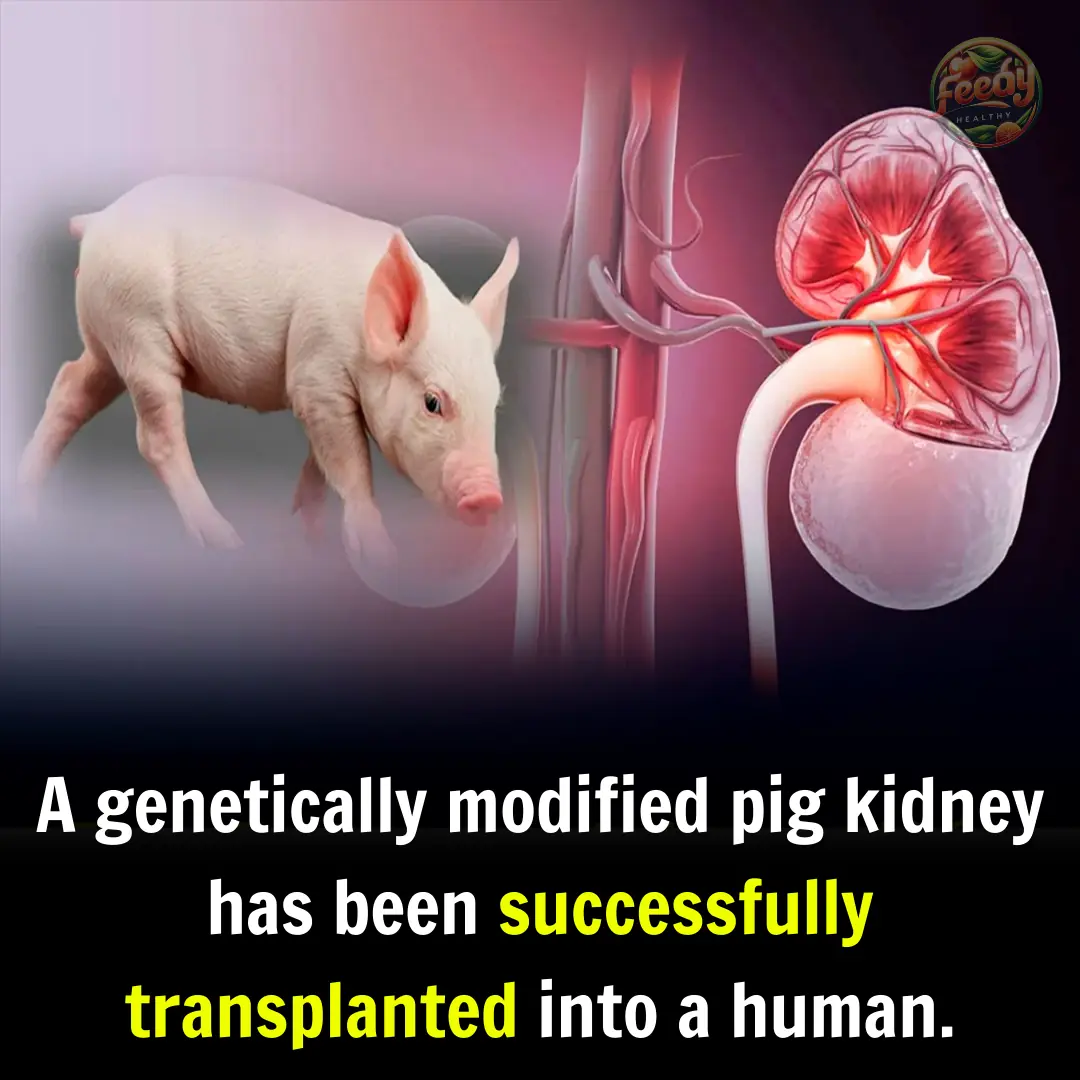
A genetically modified pig kidney has been successfully transplanted into a human.

A genetically modified pig kidney has been successfully transplanted into a human.
Organ transplantation is one of the most critical medical interventions for patients with end-stage organ failure. However, the global shortage of donor organs has prompted the search for alternatives, such as xenotransplantation—the transplantation of organs across species.
A Historic Milestone in Transplant Medicine
In a groundbreaking achievement, doctors have successfully transplanted a genetically modified pig kidney into a human patient. This breakthrough could revolutionize the treatment of end-stage kidney disease and bring new hope to thousands of people on transplant waiting lists.
What Is Xenotransplantation?
Xenotransplantation involves transplanting organs, tissues, or cells from one species to another to compensate for the lack of human donors. Although this approach has been studied for decades, challenges like immune rejection, risk of cross-species infections, and hyperacute rejection have historically limited its clinical application.
Thanks to advances in gene editing technologies—particularly CRISPR-Cas9—scientists have now overcome several of these barriers by removing key pig antigens that cause strong immune responses in humans.
The Case: A Genetically Modified Pig Kidney Transplant
A 62-year-old man suffering from kidney failure and on dialysis—who also had Type 2 diabetes, vascular disease, heart failure, and a history of a failed kidney transplant—was chosen for the procedure.
The transplanted kidney was sourced from a genetically engineered Yucatan miniature pig, with 69 gene edits, including:
- Removal of 3 glycosylation antigens responsible for hyperacute rejection.
- Inactivation of porcine endogenous retroviruses.
- Addition of 7 human genes to regulate immune response, blood coagulation, and inflammation.
The Transplant Procedure
The surgery was performed at Massachusetts General Hospital under an expanded access protocol approved by the FDA and independent ethics committees.
According to a report published in the New England Journal of Medicine, the surgical procedure was successful:
- The cold ischemia time was 4 hours and 38 minutes.
- Within five minutes of revascularization, the kidney began producing urine—an immediate sign of function.
Postoperative Results and Challenges
- Creatinine levels dropped rapidly from 11.8 to 2.2 mg/dl within six days, eliminating the need for dialysis.
- A rigorous immunosuppressive regimen was used, including thymoglobulin, rituximab, anti-CD154 and anti-C5 monoclonal antibodies, tacrolimus, mycophenolate mofetil, and prednisone.
However, on day 8, the patient experienced a T-cell-mediated rejection (Banff grade 2A), which was successfully reversed using high-dose methylprednisolone, additional thymoglobulin, and complement inhibitors.
The kidney functioned stably, maintaining an estimated glomerular filtration rate (eGFR) of 40–50 ml/min/1.73 m². Unfortunately, the patient died suddenly on day 52 from cardiac causes. Autopsy revealed advanced ischemic heart disease and ventricular fibrosis, but no signs of xenograft rejection or zoonotic infection were found.
What This Means for the Future
This case represents a major leap forward in transplant medicine. The successful function of a genetically modified pig kidney in a human opens the door to addressing the global organ shortage crisis. It also paves the way for future xenotransplantation trials involving other organs, such as the heart and liver.
More clinical studies will be necessary to assess long-term safety, manage immune suppression, and monitor cross-species infection risks. Further understanding of how pig organs behave in the human body is also essential.
Conclusion
The successful transplant of a genetically modified pig kidney into a human marks a historic achievement in medicine. While challenges remain, this breakthrough offers real hope for thousands of patients on transplant waiting lists. Ongoing clinical research and international collaboration will be crucial to turning this innovation into a safe, scalable, and global solution.
News in the same category


If Your Kidneys Are in Danger, Your Body Will Send You These 8 Signals — Don’t Ignore Them

The Surprising Effects of Avocado on Your Heart and Brain

Natural Remedy for Cataracts and Eye Inflammation: Restore Your Vision Naturally

Unlock the Golden Magic of Corn Silk Tea

9 Powerful Home Remedies to Get Rid of Fungal Infection (Daad, Khaj, Khujli) Fast

7 Shocking Health Benefits Of Eating Sweet Potatoes Every Day — According To Science

About 15 Minutes Before a Stroke, the Body Often Sends 4 Clear Warning Signs — Call Your Loved Ones Immediately

Hidden Dangers in Your Mouth: Early Signs of Oral Cancer

The Secret Power Of The Herb That Helps You Age Gracefully

The Unexpected Benefits of Eating Chicken Feet

If You See Someone with “Blue Veins,” Tell Them This — It Could Save Their Life

The Secret Power of Two Eggs a Day: Could This Simple Habit Transform Your Health? Buy vitamins and supplements

Man Passed Away After Eating Eggs — Stop Eating Eggs This Way Immediately

8 Foods That Fight Tumors — Eat Them Regularly

Does Eating Bananas Before Bed Have Any Benefits?

The Tongue as a Health Indicator: Meaning of a Whitish Color

Benefits of Boiled Eggs: Nutrition and Healthy Recipes

5 early warning signs of cervical cancer

7 Innocent Mistakes That Get Your Kidneys in Big Trouble
News Post

WHAT HAPPENS WHEN WE TONGUE KISS…See more

Nature’s Secret: 4 Healing Leaves That Support Metabolism, Immunity & Circulation Naturally

Don’t Drink Coconut Water Before You Know These 11 Secrets!

Pumpkin Seed Milk — The Natural Parasite Cleanser

Fast Rice Water Trick for a Brighter Smile

Morning Drink to Revive Your Kidneys Fast

The Onion Recipe That Could Transform Your Blood Sugar, Support Cleaner Arteries, and Protect Your Heart!

Top 4 Fruits That Help Your Kidneys Flush Out Toxins While You Sleep

Ginger, Clove, and Honey: The Natural Trio Your Body Will Thank You For

Heal 15 Years of Joint Pain Naturally with Turmeric and Honey Tea

This Juice Revived My Grandma’s Energy — Say Goodbye to Fatigue and Body Pain with This Natural Recipe

The Benefits of Eating 2 Boiled Eggs Every Morning: Transform Your Health!

If Your Kidneys Are in Danger, Your Body Will Send You These 8 Signals — Don’t Ignore Them

The Surprising Effects of Avocado on Your Heart and Brain

Ways to Get Over a Man Who Didn’t Value You

I’m 66 but Look 36 — My Secret? Aloe Vera & Ginger for Firm, Smooth Skin

How to Make Okra Water to Treat 17 Health Problems Naturally

Banana and Egg Mask to Look Younger Even in Your 80s

Scent Leaf Secrets Unveiled: 10 Surprising Health Benefits of This Miracle Herb
